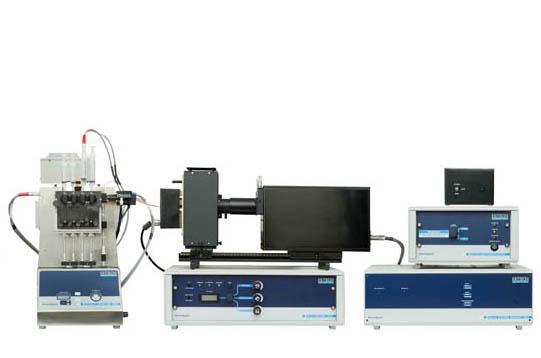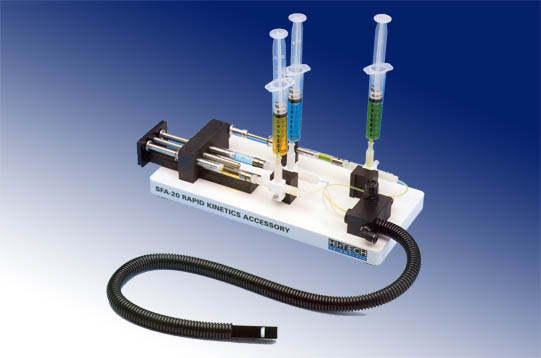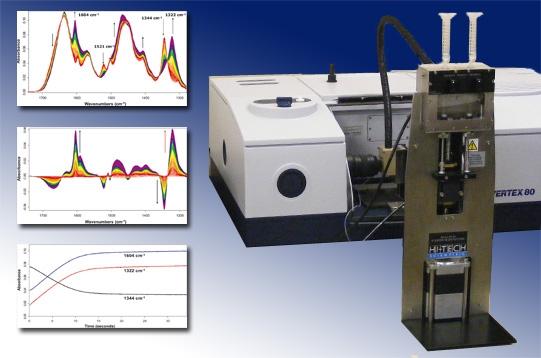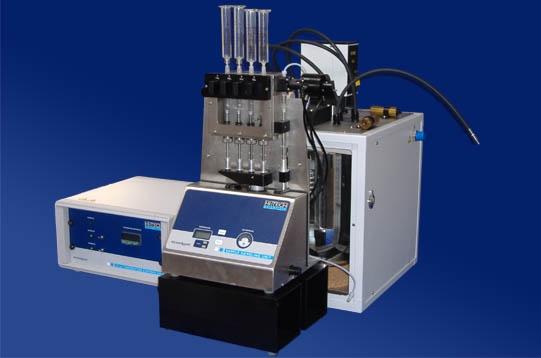Stopped-Flow
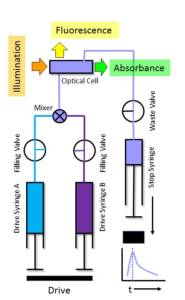
Perhaps the most frequently used rapid kinetics techniques is stopped-flow. Small volumes of solutions are rapidly driven from syringes into a high efficiency mixer to initiate a fast reaction. The resultant reaction volume then displaces the contents of an optical cell thus filling it with freshly mixed reagents. The volume injected is limited by the stop syringe which provides the “stopped-flow”. Just prior to stopping, a steady state flow is achieved. The solution entering the flow cell is only milliseconds old. The age of this reaction volume is also known as the dead time of the stopped-flow system. As the solution fills the stopping syringe, the plunger hits a block, causing the flow to be stopped instantaneously. Using appropriate techniques, the kinetics of the reaction can be measured in the optical cell.
Traditionally, stopped-flow has lent itself to UV/Vis detection methods – both by absorption and fluorescence spectroscopy and these are still the most common methods employed. TgK Scientific offer a comprehensive range of stopped-flow products from simple stopped-flow mixing accessories (SFA-20) that can be used with existing absorbance and fluorescence spectrometers to fully integrated computer controlled stopped-flow systems with dedicated acquisition and analysis software.
Mixing options for stopped-flow include multi-mixing (also known as double mixing or sequential mixing) where more than two solutions are mixed together (SF-61DX2), variable ratio mixing using different size syringes (OPT- 669) and also micro-volume mixing for applications where only very small quantities of reactants are available (OPT-689).
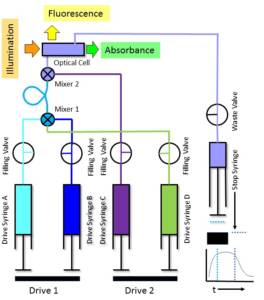
The environment of the reagents is also extremely important and so equipment is available for anaerobic, sub-zero temperature and high pressure stopped-flow applications. An extensive range of software packages is also available for the interpretation and analysis of the kinetic data.
In addition to instruments utilising UV/Vis detection methods, TgK Scientific also offers dedicated Stopped-Flow instruments for conductivity measurements and for FT-IR, FT-IR ATR and NMR spectroscopy.
- AN.001.H56
Pressure Effects On Protein-Protein Interaction In Rabbit Muscle using the HPSF-56 High Pressure Stopped-Flow System
Keywords
- High pressure stopped-flow
- Turbidity
- Muscle-protein
References
- M. A. Geeves Biochem. J. (1991) 274, 1-14
- L. E. Greene & E. Eisenberg, Proc. Natl. Acad. Sci. U. S. A. (1980) 77, 2616-2620
- M. A. Geeves & D. J. Halsall, Proc. R. Soc. London Ser. B. (1986) 229, 85-95
- AN.002.S20
Evaluation of rapid kinetics data from a vertical beam commercial spectrofluorimeter using an optimised SFA-20/PerkinElmer stopped-flow accessory
Keywords
- Stopped-flow accessory
- PerkinElmer LS-50B
- Spectrofluorimeter
- Optimised geometry
- AN.003.S60
Low absorbance studies of peroxide oxidation of mutant cytochrome c peroxidase using diode array stopped-flow techniques
Keywords
- Diode array stopped-flow
- cytochrome c peroxidase
- multi-variate global analysis
References
- ¹Biochemistry, 1989, 28, 7992, Erman et al.
- AN.004.S60
Identification of short-lived intermediates in Parahydroxybenzoate Hydroxylase mechanisms by stopped-flow techniques and global analysis.
Keywords
- Singular Value Decomposition
- short-lived intermediates
- diode-array stopped-flow
- parahydroxybenzoate hydroxylase
- multi-variate global analysis
References
- ²B. Entsch and D. Ballou, (1989), Biochim. Biophys. Acta, 999, 313-322

